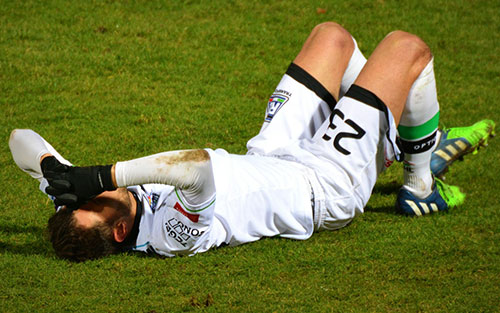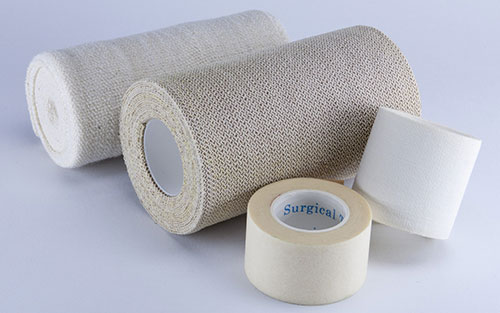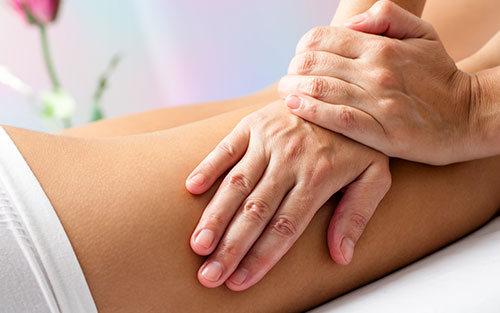Prevent a hamstring injury from stealing your mobility and active lifestyle. Knowing how to heal from a hamstring strain/pull will help you quickly get back to your normal activities.

yourfootpalace.com gathered information on what a hamstring strain is, symptoms, and what you can do to recover from it.
What is a Hamstring Strain?
A hamstring injury is the overexertion or overextension of hamstring muscles, resulting in a strain or tear to this group of muscles and tendons at the back of the thigh (the muscles that allow you to bend your leg at the knee). This is a very common injury in athletes and those who exercise frequently. The following are three grades of a hamstring injury:
Grade 1 – Mild muscle/tendon pull or strain
Grade 2 – Partial muscle/tendon tear
Grade 3 – Complete muscle/tendon rupture
Grade 1 injuries generally heal within a few days to 2 weeks, with rest and proper physical therapy. Grade 2 and 3 injuries may take several weeks or months to heal, with medical supervision, possible surgery, rest, and physical therapy.

Symptoms of a Hamstring Strain
You can generally identify a hamstring strain by the following symptoms:
- Sudden and/or sharp pain in the back of your thigh
- You may feel a “popping” or “tearing” sensation in the back of your thigh
- Swelling and/or tenderness develop in the injured area within a few hours
- Bruising or discoloration may occur along the back of your leg
- Muscle weakness
- Inability to put weight on your injured leg
Mild or grade 1 hamstring strains can usually be treated at home. More severe strains or grade 2 and 3 (cannot bear any weight on your injured leg or inability to walk 3 or 4 steps without feeling significant pain) should be seen by your doctor or primary care physician.
Hamstring Strain Recovery
Depending on your hamstring injury’s severity, recovery may take days, weeks, or even months. When you suffer a completely torn hamstring, recovery may require several months of rest and slow rehabilitation to fully recover.
Hamstring Strain Initial Treatment
During the first 72 hours after sustaining a hamstring strain, RICE therapy should be used to care for your injury:
REST – Immobilize your leg, avoiding any/all physical activity. In situations where you must move, crutches or a cane can be used to avoid aggravating your injury.
ICE – Apply a cold pack (a frozen bottle of water thinly wrapped in a towel will also work) directly to your hamstring for +/- 20 minutes every 2 to 3 hours. Avoid applying ice directly to your skin.
COMPRESSION – Use compression garments, bandages, or both around the injured thigh to reduce swelling and movement that could result in further injury.

ELEVATION – Reduce swelling by keeping your leg raised (above waist level) and comfortably supported as much as possible.
Pain relievers in the form of sports creams, gels, patches, and medicated wraps may help relieve or reduce the pain. Short-term use of oral NSAIDs, like ibuprofen, may help to reduce inflammation.
Disclaimer: Always check with your doctor or primary care physician before using any form of medication (topical or oral).
Hamstring Strain Recovery Exercises
Returning to sports activities or strenuous exercise too quickly could aggravate or worsen your injury. However, avoiding stretch and exercise for too long may result in the shrinking of your hamstring muscles and scar tissue formation around the initial injury.
For grade 1 strains, you should be able to start doing gentle stretches and mild exercises after a few days or when the pain begins to subside. For grade 2 or 3 strains, you may have to wait weeks or months (in severe cases) to begin stretches or exercises under the supervision of a physiotherapist. The following exercises will help you on your way to reintroducing load, tolerance, and mobility to the hamstrings:
Hamstring Bridge
- Lie on your back with your hips bent and your feet flat, lined up with your shoulders.
- Lift both hips from the floor.
- Hold the bridge position for a few seconds and return to the starting position.
- Walk your feet out 1 step away from your body.
- Lift both hips from the floor.
- Hold the bridge position for a few seconds and return to the starting position.
- Repeat steps 4, 5, and 6 two more times.
- Return to the original position and start again.

Hamstring Curls
- Lie face down with your knees straight.
- Lift the foot of your strained leg by bending your knee so that you bring your foot up toward your hips. If this exercise hurts, try bending your leg less.
- Slowly raise and lower your leg.
- Repeat 10 to 12 times.
Hamstring Isometrics
This exercise is identical to hamstring curls except using your foot (on your unaffected leg) to hook the affected leg and provide resistance to the curling motion.
Start with mild resistance and increase as you can tolerate it.
Hamstring Extenders
- Lie on your back, holding your affected thigh with both hands (use a towel if necessary).
- Your opposite leg remains straight.
- With your upper thigh in a vertical position, slowly extend your knee (bringing your foot upward).
- When you feel a mild stretch, pause, and hold.
- Extend your knee further, pause, and hold again.
- Repeat this exercise in three sets of ten repetitions daily.
Note: None of the above or other recommended stretches should be painful. The gentle stretching of your hamstring is highly beneficial for recovery.
Watch this video to see how these exercises are performed.
Hamstring Injury Recovery
Physical activity and exercise should begin gradually, as you increase weight load on the affected leg without experiencing pain. The following will help you strengthen your hamstring as you recover:
Walk – Take it slow and increase your speed and distance incrementally. If you need to use a cane or crutches to walk, it is likely too soon for this level of exertion.
Ride a Bike – If you can, start with an exercise bike before moving on to a bicycle. Again, start slow and build up resistance incrementally.
Yoga – Return to or start regular yoga exercises.
Massage – As your leg heals, you may get a sense of stiffness or soreness. A gentle massage to the thigh or a reflexology massage can help these sensations subside.

Hamstring Strain
In this article, you discovered information about hamstring strains, identifying symptoms, and how to recover from the injury.
Knowing what to do when you pull or strain your hamstring will help you minimize the time it takes to recover from this injury.
Trying to force your way back into your regular activities after a hamstring injury can worsen the injury, severe pain, and potential surgical intervention.
Sources:
mayoclinic.org/diseases-conditions/hamstring-injury/symptoms-causes/syc-20372985
healthy.kaiserpermanente.org/health-wellness/health-encyclopedia/he.hamstring-strain-rehab-exercises.bo1577
hss.edu/conditions_hamstring-injuries.asp
nhs.uk/conditions/hamstring-injury/
(706) 521-5290
(678) 963-5958
To view the original version on Foot Palace, visit: https://www.yourfootpalace.com/hamstring-strain-rehab/
No comments:
Post a Comment
Note: Only a member of this blog may post a comment.